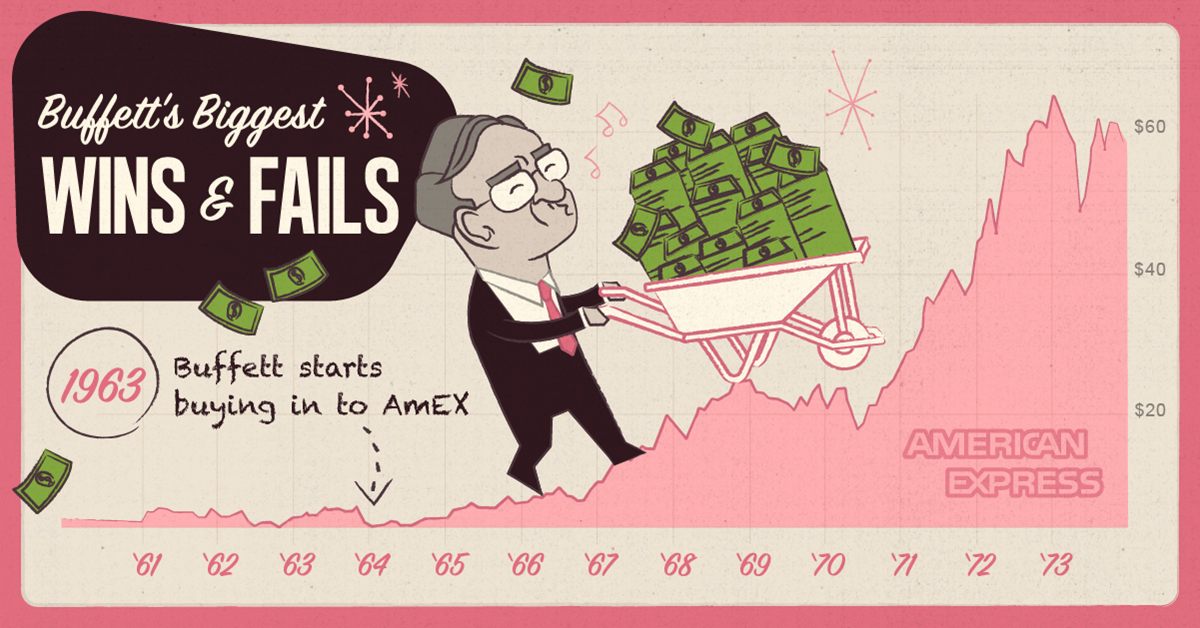Markets
Warren Buffett’s Biggest Wins & Fails
Warren Buffett’s investing track record is nearly impeccable.
Over his lifetime, Buffett has built Berkshire Hathaway into one of the biggest companies in American history, amassed a personal fortune of over $80 billion, and earned acclaim as one of the world’s foremost philanthropists.
But in a 75-year career, it’s no surprise that even Buffett has made the odd blunder – and there’s one that he claims has ultimately costed him an estimated $200 billion!
The Warren Buffett Series
Part 4: Buffett’s Biggest Wins and Fails
Today’s infographic highlights Buffett’s investing strokes of genius, as well as a few decisions he would take back.
It’s the fourth part of the Warren Buffett Series, which we’ve done in partnership with finder.com, a personal finance site that helps people make better decisions – whether they want to dabble in cryptocurrencies or become the next famous value investor.

Note: New series parts will be released intermittently. Stay tuned for future parts with our free mailing list.
How did Buffett go from local paperboy to the world’s most iconic investor?
Here are the backstories behind five of Warren’s biggest acts of genius. These are the events and decisions that would propel his name into investing folklore for centuries to come.
Buffett’s 5 Biggest Wins
From making shrewd value investing calls to taking advantage of misfortune in the salad oil market, here are some of the stories that are Buffett classics:
1. GEICO (1951)
At 20 years old, Buffett was attending Columbia Business School, and was a student of Benjamin Graham’s.
When young Buffett learned that Graham was on the board of the Government Employees Insurance Company (GEICO), he immediately took a train to Washington, D.C. to visit the company’s headquarters.
On a Saturday, Buffett banged on the door of the building until a janitor let him in, and Buffett met Lorimer Davidson – the future CEO of GEICO. Ultimately, Davidson spent four hours talking to this “highly unusual young man”.
He answered my questions, taught me the insurance business and explained to me the competitive advantage that GEICO had. That afternoon changed my life.
– Warren Buffett
By Monday, Buffett was “more excited about GEICO than any other stock in [his] life” and started buying it on the open market. He put 65% of his small fortune of $20,000 into GEICO, and the money he earned from the deal would provide a solid foundation for Buffett’s future fortune.
Although Buffett sold GEICO after locking in solid gains, the stock would rise as much as 100x over time. Buffett bought his favorite stock again a few years later, loaded up further during the 1970s, and eventually bought the whole company in the 1990s.
2. Sanborn Maps (1960)
This early deal may not be Buffett’s biggest – but it’s the clearest case of Benjamin Graham’s influence on his style.
Sanborn Maps had a lucrative business around making city maps for insurers, but eventually its mapping business started dying – and the falling stock price reflected this trend.
Buffett, after diving deep into the company’s financials, realized that Sanborn had a large investment portfolio that was built up over the company’s stronger years. Sanborn’s stock was worth $45 per share, but the value of the company’s investments tallied to $65 per share.
In other words, these investments held by the company were alone worth more than the stock – and that didn’t include the actual value of the map business itself!
Buffett accumulated the stock in 1958 and 1959, eventually putting 35% of his partnership assets in it. Then, he became a director, and convinced other shareholders to use the investment portfolio to buy out stockholders. He walked away with a 50% profit.
3. The Salad Oil Swindle (1963)
For a value investor like Buffett, every mishap is a potential opportunity.
And in 1963, a con artist named Anthony “Tino” De Angelis inadvertently set Buffett up for a massive home run. After De Angelis attempted to corner the soybean oil market using false inventories and loans, the market subsequently collapsed.
American Express – the world’s largest credit card company at the time – got caught up in the disaster, and its stock price halved as investors thought the company would fail.
Although everyone else panicked, Buffett knew the scandal wouldn’t affect the overall value of the business. He was right – and bought 5% of American Express for $20 million. By 1973, Buffett’s investment increased ten times in value.
4. Capital Cities / ABC (1985)
In the 1980s, corporate raiders and takeover madness reigned supreme.
The massive TV network ABC found itself vulnerable, and sold itself to a company that promised to keep its legacy intact. Capital Cities, a relative unknown and a fraction of the size, had somehow managed to buy ABC.
The CEO of Cap Cities, Tom Murphy – one of Buffett’s favorite managers in the world – gave Warren a call:
Pal, you’re not going to believe this. I’ve just bought ABC. You’ve got to come and tell me how I’m going to pay for it.
– Tom Murphy, Capital Cities CEO
Berkshire dropped $500 million to finance the deal. This turned Buffett into Murphy’s much-needed “900-lb gorilla” – a loyal shareholder that would hold onto shares regardless of price, as Murphy figured out how to turn the company around.
It turned out to be a fantastic gamble for Buffett, as Capital Cities/ABC sold to Disney for $19 billion in 1995.
5. Freddie Mac (1988)
Buffett started loading up on shares of Freddie Mac in 1988 for $4 per share.
By 2000, Buffett noticed the company was taking unnecessary risks to deliver double-digit growth. This risk, and its short-term focus, turned Buffett off the company. As a result, at a share price close to $70, he sold virtually all of his holdings, enjoying a return of more than 1,500%.
I figure if you see just one cockroach, there’s probably a lot.
– Warren Buffett
Later on, Freddie Mac’s business would collapse in the housing crisis, only to be taken over by the U.S. federal government. Today, its stock sells for a mere $1.50 per share.
Buffett’s Blunders
Over the course of 75 years, it’s not surprising that even Buffett has made some serious mistakes. Here are his costliest ones:
1. Berkshire Hathaway (1962)
When Buffett first invested in Berkshire Hathaway, it was a fledgling textile company.
Buffett eventually tried to pull out, but the company changed the terms of the deal at the last minute. Buffett was spiteful, and loaded up with enough stock to fire the CEO that deceived him.
The textiles business was terrible and sucked up capital – and Berkshire unintentionally would become Buffett’s holding company for other deals. This mistake, he estimates, costed him an estimated $200 billion.
2. Dexter Shoes (1993)
Dexter Shoe Co. had a long, profitable history, an enduring franchise, and suberb management. In other words, it was the exact kind of company Buffett liked.
Buffett dropped $433 million in 1993 to buy the company, but the company’s competitive advantage soon waned. To make matters worse, Warren Buffett financed the deal with Berkshire’s own stock, compounding the mistake hugely. It ended up costing the company $3.5 billion.
To date, Dexter is the worst deal that I’ve made. But I’ll make more mistakes in the future – you can bet on that.
– Warren Buffett
Later on, Buffett would say that this deal deserved a spot in the Guinness Book of World Records as a top financial disaster.
3. Amazon.com (2000s)
Buffett says not buying Amazon was one of his biggest mistakes.
I did not think [founder Jeff Bezos] could succeed on the scale he has. [I] underestimated the brilliance of the execution.
– Warren Buffett
Given that Amazon has shot up in value to become one of the most valuable companies in the world, and that Jeff Bezos is by now the far richest person globally, it’s fair to say this whiff continues to haunt Buffett to this day.
Markets
The European Stock Market: Attractive Valuations Offer Opportunities
On average, the European stock market has valuations that are nearly 50% lower than U.S. valuations. But how can you access the market?

European Stock Market: Attractive Valuations Offer Opportunities
Europe is known for some established brands, from L’Oréal to Louis Vuitton. However, the European stock market offers additional opportunities that may be lesser known.
The above infographic, sponsored by STOXX, outlines why investors may want to consider European stocks.
Attractive Valuations
Compared to most North American and Asian markets, European stocks offer lower or comparable valuations.
| Index | Price-to-Earnings Ratio | Price-to-Book Ratio |
|---|---|---|
| EURO STOXX 50 | 14.9 | 2.2 |
| STOXX Europe 600 | 14.4 | 2 |
| U.S. | 25.9 | 4.7 |
| Canada | 16.1 | 1.8 |
| Japan | 15.4 | 1.6 |
| Asia Pacific ex. China | 17.1 | 1.8 |
Data as of February 29, 2024. See graphic for full index names. Ratios based on trailing 12 month financials. The price to earnings ratio excludes companies with negative earnings.
On average, European valuations are nearly 50% lower than U.S. valuations, potentially offering an affordable entry point for investors.
Research also shows that lower price ratios have historically led to higher long-term returns.
Market Movements Not Closely Connected
Over the last decade, the European stock market had low-to-moderate correlation with North American and Asian equities.
The below chart shows correlations from February 2014 to February 2024. A value closer to zero indicates low correlation, while a value of one would indicate that two regions are moving in perfect unison.
| EURO STOXX 50 | STOXX EUROPE 600 | U.S. | Canada | Japan | Asia Pacific ex. China |
|
|---|---|---|---|---|---|---|
| EURO STOXX 50 | 1.00 | 0.97 | 0.55 | 0.67 | 0.24 | 0.43 |
| STOXX EUROPE 600 | 1.00 | 0.56 | 0.71 | 0.28 | 0.48 | |
| U.S. | 1.00 | 0.73 | 0.12 | 0.25 | ||
| Canada | 1.00 | 0.22 | 0.40 | |||
| Japan | 1.00 | 0.88 | ||||
| Asia Pacific ex. China | 1.00 |
Data is based on daily USD returns.
European equities had relatively independent market movements from North American and Asian markets. One contributing factor could be the differing sector weights in each market. For instance, technology makes up a quarter of the U.S. market, but health care and industrials dominate the broader European market.
Ultimately, European equities can enhance portfolio diversification and have the potential to mitigate risk for investors.
Tracking the Market
For investors interested in European equities, STOXX offers a variety of flagship indices:
| Index | Description | Market Cap |
|---|---|---|
| STOXX Europe 600 | Pan-regional, broad market | €10.5T |
| STOXX Developed Europe | Pan-regional, broad-market | €9.9T |
| STOXX Europe 600 ESG-X | Pan-regional, broad market, sustainability focus | €9.7T |
| STOXX Europe 50 | Pan-regional, blue-chip | €5.1T |
| EURO STOXX 50 | Eurozone, blue-chip | €3.5T |
Data is as of February 29, 2024. Market cap is free float, which represents the shares that are readily available for public trading on stock exchanges.
The EURO STOXX 50 tracks the Eurozone’s biggest and most traded companies. It also underlies one of the world’s largest ranges of ETFs and mutual funds. As of November 2023, there were €27.3 billion in ETFs and €23.5B in mutual fund assets under management tracking the index.
“For the past 25 years, the EURO STOXX 50 has served as an accurate, reliable and tradable representation of the Eurozone equity market.”
— Axel Lomholt, General Manager at STOXX
Partnering with STOXX to Track the European Stock Market
Are you interested in European equities? STOXX can be a valuable partner:
- Comprehensive, liquid and investable ecosystem
- European heritage, global reach
- Highly sophisticated customization capabilities
- Open architecture approach to using data
- Close partnerships with clients
- Part of ISS STOXX and Deutsche Börse Group
With a full suite of indices, STOXX can help you benchmark against the European stock market.

Learn how STOXX’s European indices offer liquid and effective market access.

-

 Economy1 day ago
Economy1 day agoEconomic Growth Forecasts for G7 and BRICS Countries in 2024
The IMF has released its economic growth forecasts for 2024. How do the G7 and BRICS countries compare?
-

 Markets1 week ago
Markets1 week agoU.S. Debt Interest Payments Reach $1 Trillion
U.S. debt interest payments have surged past the $1 trillion dollar mark, amid high interest rates and an ever-expanding debt burden.
-

 United States1 week ago
United States1 week agoRanked: The Largest U.S. Corporations by Number of Employees
We visualized the top U.S. companies by employees, revealing the massive scale of retailers like Walmart, Target, and Home Depot.
-

 Markets2 weeks ago
Markets2 weeks agoThe Top 10 States by Real GDP Growth in 2023
This graphic shows the states with the highest real GDP growth rate in 2023, largely propelled by the oil and gas boom.
-

 Markets2 weeks ago
Markets2 weeks agoRanked: The World’s Top Flight Routes, by Revenue
In this graphic, we show the highest earning flight routes globally as air travel continued to rebound in 2023.
-

 Markets2 weeks ago
Markets2 weeks agoRanked: The Most Valuable Housing Markets in America
The U.S. residential real estate market is worth a staggering $47.5 trillion. Here are the most valuable housing markets in the country.
-

 Mining1 week ago
Mining1 week agoGold vs. S&P 500: Which Has Grown More Over Five Years?
-

 Markets2 weeks ago
Markets2 weeks agoRanked: The Most Valuable Housing Markets in America
-

 Money2 weeks ago
Money2 weeks agoWhich States Have the Highest Minimum Wage in America?
-

 AI2 weeks ago
AI2 weeks agoRanked: Semiconductor Companies by Industry Revenue Share
-

 Markets2 weeks ago
Markets2 weeks agoRanked: The World’s Top Flight Routes, by Revenue
-

 Demographics2 weeks ago
Demographics2 weeks agoPopulation Projections: The World’s 6 Largest Countries in 2075
-

 Markets2 weeks ago
Markets2 weeks agoThe Top 10 States by Real GDP Growth in 2023
-

 Demographics2 weeks ago
Demographics2 weeks agoThe Smallest Gender Wage Gaps in OECD Countries


















